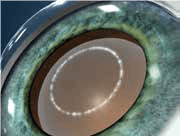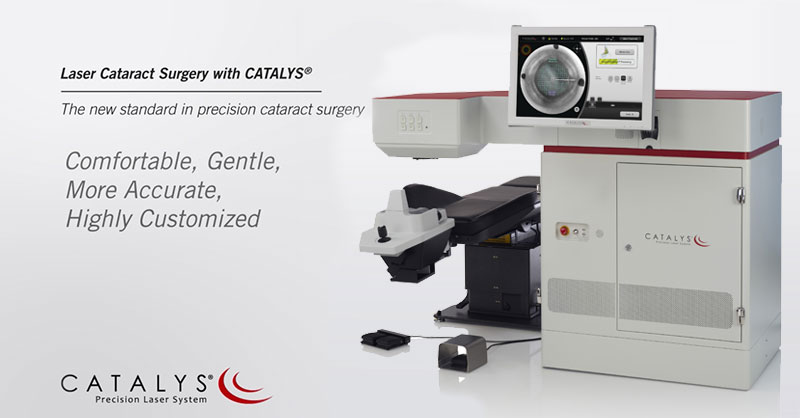How Is A Cataract Removed?
There are two primary ways to remove a cataract. Dr. McMickle will explain the differences and help determine which is best for you.
- Phacoemulsification, or Phaco: Dr. McMickle makes a small incision on the side of the cornea, the clear, dome-shaped surface that covers the front of the eye. He then inserts a tiny probe into the eye. This device emits ultrasound waves that soften and break up the cataract so it can be removed by suction. Most cataract surgeries today are done by phaco, which is also called small incision cataract surgery.
- Extracapsular Surgery: Dr. McMickle makes a slightly longer incision on the side of the cornea and removes the hard center of the lens. The remainder of the lens is removed by suction.
In most cataract surgeries, the removed lens is replaced by an intraocular lens (IOL). An IOL is a clear, artificial lens that requires no care and becomes a permanent part of your eye.
With an IOL, you’ll have improved vision because the light will be able to pass through it to the retina. Also, you won’t feel or see the new lens.
Some people cannot have an IOL. They may have problems during surgery, or maybe they have another eye disease.
For these people, a soft contact lens may be suggested. For others, glasses that provide powerful magnification may be better.

What Happens Before Cataract Surgery?
A week or two before surgery, your eye care professional will do some tests. These may include tests to measure the curve of the cornea and the size and shape of the eye.
For patients who will receive an IOL, this information helps the surgeon choose the right type of IOL. Also, you will be given your instructions before surgery.
What Happens During Surgery?
When you enter the surgery center, you will be given eye drops to dilate the pupil. The area around your eye will be cleansed.
The operation usually lasts less than one hour and is almost painless. Many people stay awake during the surgery, while others need to be put to sleep for a short time. If you are awake you will have an anesthetic to numb the nerves in and around your eye.
After the operation, a patch sometimes will be placed over your eye and you will rest for a while.
You will be watched by the medical team to see if there are any problems, such as bleeding. Since you will not be able to drive, make sure you make arrangements for a ride.
What Happens After Cataract Surgery?
 It’s normal to feel itching and mild discomfort for a while after cataract surgery. Some fluid discharge is also common, and your eye may be sensitive to light and touch.
It’s normal to feel itching and mild discomfort for a while after cataract surgery. Some fluid discharge is also common, and your eye may be sensitive to light and touch.
If you have discomfort, Dr. McMickle may suggest a pain reliever every 4-6 hours. After 1-2 days, even moderate discomfort should disappear. In most cases, healing will take about 6 weeks.
After surgery, Dr. McMickle will schedule exams to check your progress. For a few days after surgery, you may take eye drops or pills to help healing and control pressure inside the eye.
Ask your doctor how to use your medications, when to take them, and what effects they can have. You will need to wear an eye shield or eyeglasses to help protect the eye. Avoid rubbing or pressing on your eye.
When you are home, try not to bend or lift heavy objects. Bending increases pressure in the eye. You can walk, climb stairs, and do light household chores.
When Will My Vision Be Normal Again?
You can quickly return to many everyday activities, but your vision may be blurry. The healing eye needs time to adjust so that it can focus properly with the other eye, especially if the other eye has a cataract. Ask Dr. McMickle when you can resume driving.
If you just received an IOL, you may notice that colors are very bright or have a blue tinge. Also, if you’ve been in bright sunlight, everything may be reddish for a few hours.
If you see these color tinges, it is because your lens is very clear and no longer cloudy. Within a few months after receiving an IOL, these colors should go away. When you have healed, you will probably need new glasses.
If you want to minimize or attempt to eliminate your need for glasses, click here to learn more about the Lifestyle Lenses available at Southwestern Eye Associates

Laser to Soften the Hard Cataract
Dr. McMickle and Southwestern Eye Associates are proud to bring our patients the CATALYS® Precision Laser System.
The latest technology in cataract surgery is the CATALYS® Precision Laser System. Known to be the world’s most sophisticated laser cataract surgery machine, the CATALYS® laser can replace the use of traditional handheld blades.
Laser Precision
Your surgeon can use the CATALYS® Laser to create precise CATALYS® Laser incisions in the cornea to treat astigmatism and a precise circular opening in the lens capsule to access and remove the cataract.
This precise incision helps your surgeon place the new artificial lens where intended.


Customization With 3D Imaging
Like a fingerprint, every eye has a unique size and shape. Prior to treatment, the CATALYS® Laser takes images of the eye and makes precise 3D maps of relevant structures.
This enables your surgeon to create a tailored treatment plan that is uniquely customized to your eye.
Gentle Approach
Your surgeon can use the laser to soften the hard cataract. Softening the lens with the CATALYS® Laser enables your surgeon to remove the cataract gently.

Southwestern Eye Associates is proud to offer this advanced procedure. If you are interested in learning about the qualifications, process, and cost of CATALYS®, please contact us.

